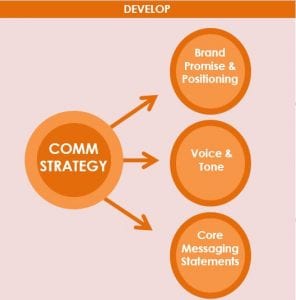Without a communication strategy, your senior living or 55+ organization will struggle to develop its own voice and stand out from all the other options in the market. But in just 5 steps, your team can develop a strategy that will help your prospects recognize you in a crowded marketplace and complement your organization’s business goals.
1. Do Your Research
Before you can develop your senior living or 55+ organization’s communication strategy, it’s important to understand how internal and external stakeholders, as well as your prospects, perceive your brand and how it compares to competitors.
This research phase may take extra time, but without it, you won’t have a solid foundation on which to build your communication strategy. Research allows you to collect information on how team members and prospects feel about your product directly from the source rather than having to guess or assume. You may think you know what the internal and external opinions of your product are, but you’d be surprised at what you can uncover when you ask the people whose opinions can dictate the success of your product or service.

The process for collecting these insights looks different for every community, but the end goal is the same. An important tool to use during this stage is a Venn diagram that will allow you to compare the overlap between what your prospects value and what your community offers versus your competitors’ offerings and how they position their communities.
It will also help you understand your organization’s own strengths and internal challenges. There are several ways to glean these insights, including focus groups with team members, residents, prospects, etc.; secret shops of competitors and your own community; an audit of your community’s sales and marketing processes and other types of marketing research.
Your team and its partners will need to compile all of the insights collected together and the current positive and negative perceptions of your organization, strengths and weaknesses in your service offerings, gaps in the market you can fill and what your target customer wants from your product.
With this information in hand, you’ll be ready to begin documenting your communication strategy.
2. Develop a Format for Your Communication Strategy
There’s no one way to set up a communication strategy. You can keep things simple with a Word document, opt for something a little fancier in PowerPoint or even download a template online that will let you plug in all the elements you’ll need for your organization’s strategy. At Creating Results, we prefer to house our clients’ (and our own) communication strategies in a PowerPoint deck due to its ease of use.
A communication strategy lies somewhere in between being a living document and a static one. The way you communicate with your audience will likely change over time, and you’ll want to update your strategy as that happens. However, changes to the strategy shouldn’t occur often — possibly once or twice a year, if at all.
3. Add Your Unique Selling Propositions (USPs) and Core Messaging Statements
What are the two or three things your organization does differently from/better than its competitors? Those are its USPs. For example, if your community is the only one in the area offering lifecare to its residents, that’s something you’ll want to highlight in your messaging and explain to prospects how it will improve their lives.
Your organization’s USPs will then guide the communication strategy’s core messaging statements. For example, based on the idea that your community is the only one in the area offering lifecare, one of your core messaging statements could be: Our residents have peace of mind knowing they can remain in our community should their health care needs change thanks to our lifecare guarantee. You’ll then want to have two or three subpoints that strengthen each of your core messaging statements.
4. Communicate Your Brand’s Positioning and Promise
The next part of your communication strategy involves solidifying your brand’s positioning and its promise
Your brand position is an internal statement that describes your product or service and how it benefits consumers in a way your competition’s does not. Your internal brand position should be brief and can borrow from the following format suggested by Hubspot:
For [your target marketing] who [target marketing need], [your brand name] provides [main benefit that differentiates your offering from competitors] because [reason why target market should believe your differentiation statement].
The brand promise is an external statement and should communicate what your organization commits to the people who interact with it. It can follow a similar format to the brand position, but will read differently given that it’s meant for the consumer’s eyes.

5. Give Your Brand a Voice and Tone
How else can you make your organization stand out from its competitors in the marketplace? By giving it its own unique voice. Voice and tone are vital elements of your communication strategy, with voice being the character of your brand and tone being how your brand sounds in certain instances.
To make it easier to understand, think of voice as your favorite musician’s entire album and tone as one of the songs on the album.
Every brand has a voice and tone. Apple is clean, simple and confident. Coke is friendly and joyful. What character do you want your organization to evoke to customers? Aspirational? Casual? Elegant? This is what you’ll determine as you choose 1-3 traits that will comprise your organization’s personality, as well as tone characteristics to complement them.
 The next part of constructing your brand’s personality is specifying the dos and don’ts when it comes to communicating with your prospects in your marketing. For example, anyone writing for your brand should use strong, motivating verbs and refrain from sounding pushy or using passive voice.
The next part of constructing your brand’s personality is specifying the dos and don’ts when it comes to communicating with your prospects in your marketing. For example, anyone writing for your brand should use strong, motivating verbs and refrain from sounding pushy or using passive voice.
Finally, you’ll want to develop a short list of words that that will be recurring in all of your messaging and marketing materials. Dynamic, active, lifestyle, value — what are the terms you want your customers to associate with your organization? That’s what you should be contemplating as you complete this portion of your communication strategy.
With the final touches added to your brand, the last step is to roll it out to your internal team and partner organizations. All members of the team should take responsibility in upholding your brand’s values and communicating within the guidelines outlined in the strategy.
Now, it’s time for your brand’s new voice to be heard!


